Chapter 2.
IMPERATOR ANDRONICUS KOMNIN OF THE XII CENTURY - IT IS JESUS CHRIST DURING HIS PRESENCE IN TSAR-GRAD OF THE XII CENTURY.
33. THE SEVERED RIGHT HAND OF ANDRONICUS AND THE IMPLICIT LACERATION OF CHRIST’S HAND ON THE SHROUD.
Nicetas Choniates reports that a few days before Andronicus’ eye was gouged out and he was led to his crucifixion, HIS RIGHT HAND WAS SEVERED’. In the end they cut his right hand off with a hatchet and threw him to the same prison’ [140], p.357. In the Gospels nothing is said about Christ’s amputated hand. However in the book ‘Passion of Christ’ it is said that his hands and feet were ‘beaten off’ [127], p.63. It is possible that here shines through the memory of the amputated hand. As the meaning of the words ‘BEAT OFF’ or ‘CUT OFF’ is close enough.
Let us turn to the Shroud. If in fact Christ hand was cut off, then the traces of that should be visible in the Shroud. The photograph of an area in the Shroud depicting the hands is shown in fig.2.77 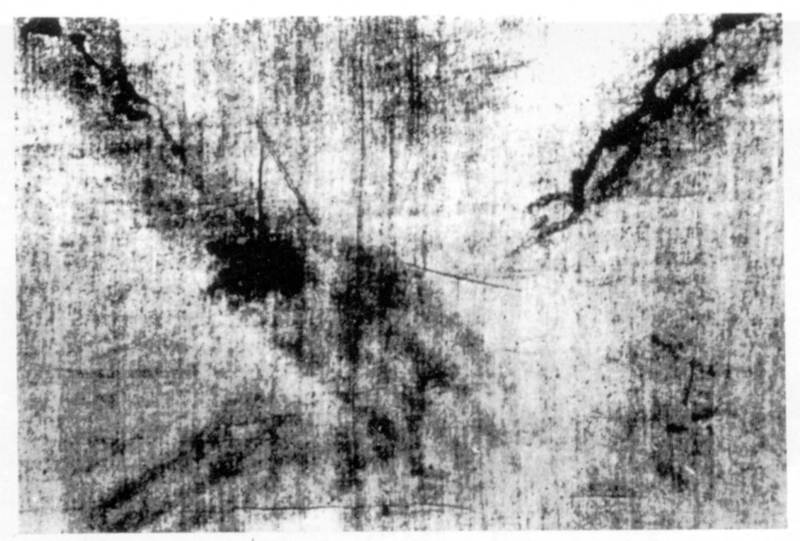 . Here it makes sense to elaborate that the depiction of the body in the Shroud is given as a mirror reflection – as the imprint on the cloth, similar to the reflection in the mirror, swapping right and left. The positive image of the hands in the Shroud with the natural positioning of left and right is shown in fig. 2.78
. Here it makes sense to elaborate that the depiction of the body in the Shroud is given as a mirror reflection – as the imprint on the cloth, similar to the reflection in the mirror, swapping right and left. The positive image of the hands in the Shroud with the natural positioning of left and right is shown in fig. 2.78 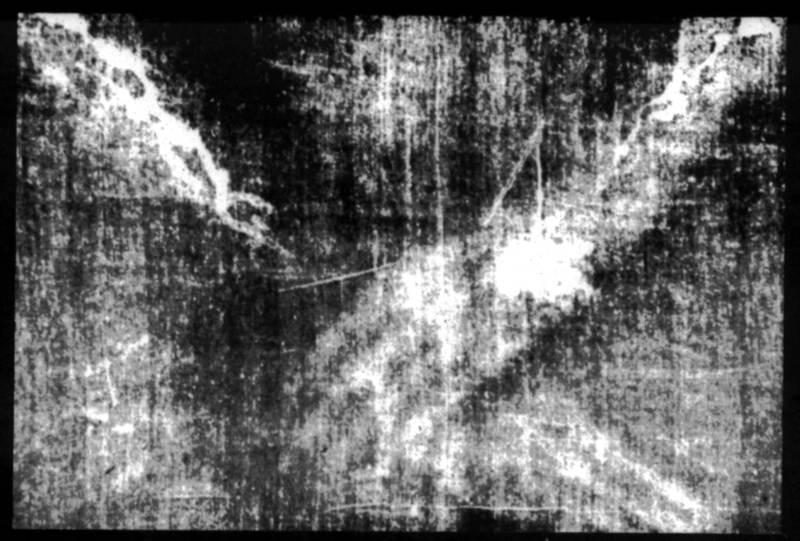 . The left hand is above and on its wrist there can be seen an enormous wound. It is thought that this is a nail wound [47], p.15. On Christ’s hand we in fact do see a laceration between the wrist and the hand itself. It is of course difficult to claim with absolute certainty, but according to the image in the Shroud there was something wrong with the right hand. It is possible that the hand was cut off and then later was put next to the dead body. In order for the cut off hand to stay attached, the left hand was placed above it.
. The left hand is above and on its wrist there can be seen an enormous wound. It is thought that this is a nail wound [47], p.15. On Christ’s hand we in fact do see a laceration between the wrist and the hand itself. It is of course difficult to claim with absolute certainty, but according to the image in the Shroud there was something wrong with the right hand. It is possible that the hand was cut off and then later was put next to the dead body. In order for the cut off hand to stay attached, the left hand was placed above it.
We would like to point out that as the photograph presented in [66] is a mirror image, it looks as if the right hand is placed on top. But the study [47], p.15, clearly claims that it is exactly the left hand which is placed on top. We quote: ‘Also there can be seen three wounds, received as a result of the crucifixion: in front on the left wrist and behind on both soles of his feet. ON THE RIGHT WRIST COVERED WITH THE LEFT there is visible only blood from the wound’ [47], p.15.
And so here we also come across a remarkably precise correspondence between the description of Andronicus’ execution and testaments about Christ.
We will add that the theme of the cut off right hand is also resonant in the life description of Andrey Bogolyubskiy – another duplicate of Christ, which we discovered in the Russian history of the XII century. Moreover there survive the ancient images depicting Andrey Bogolyubsky’s hand being cut off. See the details in the following chapter 3.
We haven’t succeeded yet in finding any ancient images of Christ with his hand cut off. However there survive some images in which possibly the memory of Jesus’ cut off hand is evident and sometime quite vividly. Fig.2.79 shows for example Correggio’s painting ‘Ecce Homo’. There is a crown of thorns on Christ’s head, there is a soldier next to him and the Virgin Mary has fainted. On Christ’s hand we see to our surprise some kind of strange bandage, some kind of bracelet of three thin rings clasping his hand as if separating it from a hand from the arm, see fig.2.80
shows for example Correggio’s painting ‘Ecce Homo’. There is a crown of thorns on Christ’s head, there is a soldier next to him and the Virgin Mary has fainted. On Christ’s hand we see to our surprise some kind of strange bandage, some kind of bracelet of three thin rings clasping his hand as if separating it from a hand from the arm, see fig.2.80 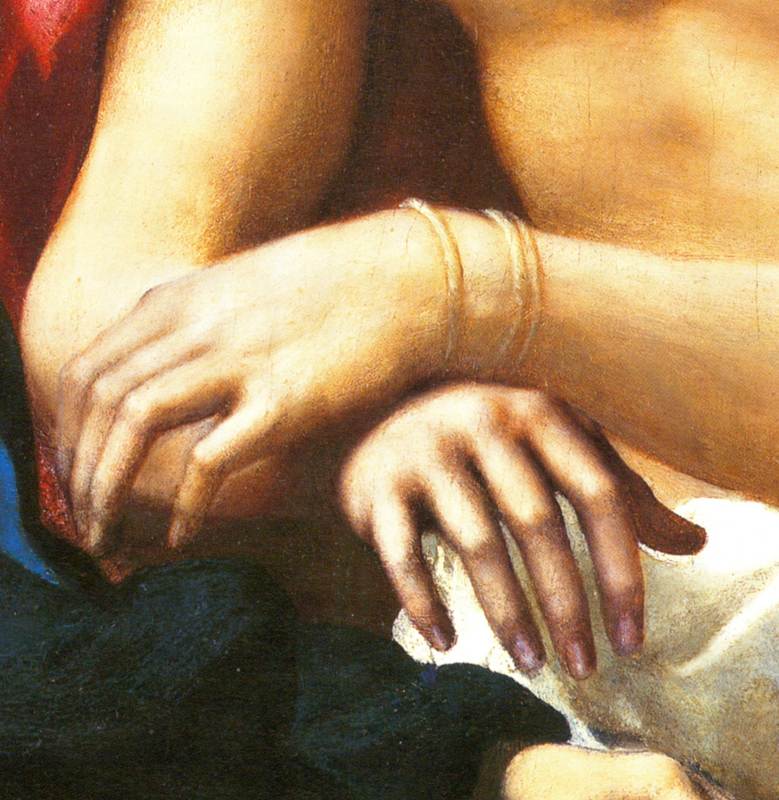 . This detail looks rather weird. It is possible that in this way the vague memory of Jesus’ cut off hand survives until our time. The strange ‘bandage’ is represented only on one of Jesus’ hands. In any case when we enlarged the image, we could not find any similar marks on the other hand of Jesus.
. This detail looks rather weird. It is possible that in this way the vague memory of Jesus’ cut off hand survives until our time. The strange ‘bandage’ is represented only on one of Jesus’ hands. In any case when we enlarged the image, we could not find any similar marks on the other hand of Jesus.
Fig.2.81 presents another interesting old image of The Passion of Christ. Surrounding Christ there are shown various plots: the kiss of Judas; the sword of St. Peter with which he cut off the ear of the soldier (with which the Apostle Peter cut off the ear of the high priest's servant); the Spear of Longinus piercing the side of Jesus on the cross; sponge on a stick, etc. It is interesting that there are nine cut off hands depicted here. There are shown, for example, Pilates’ hands when he was washing them. Similarly in the painting ‘The Mocking of Christ’ by Fra Angelico we also see the severed hands surrounding Christ, see fig.2.82
presents another interesting old image of The Passion of Christ. Surrounding Christ there are shown various plots: the kiss of Judas; the sword of St. Peter with which he cut off the ear of the soldier (with which the Apostle Peter cut off the ear of the high priest's servant); the Spear of Longinus piercing the side of Jesus on the cross; sponge on a stick, etc. It is interesting that there are nine cut off hands depicted here. There are shown, for example, Pilates’ hands when he was washing them. Similarly in the painting ‘The Mocking of Christ’ by Fra Angelico we also see the severed hands surrounding Christ, see fig.2.82 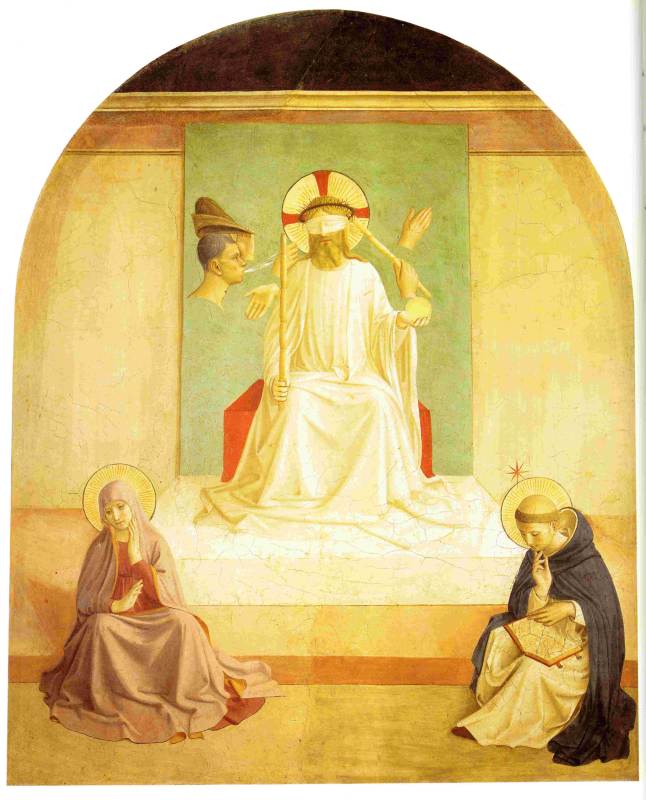 .
.
Here we presumably come across some kind of symbolism. But it is possible that the artist still vaguely remembered that in Passion of Christ in some form there occurred Christ’s severed hand. The core of the matter was already forgotten, but the tradition of painting ‘severed hands’ was still alive. It is worth noting that such symbolism of the ‘severed hands surrounding the hero’ for some reason was associated specifically with Christ. We are not aware of any other historical figures depicted by the Mediaeval artists where they thought it necessary to surround them with the ‘severed hands’ floating in the air, so to speak. But when they presented Passion of Christ, as we saw, they sometimes employed such symbolism.
Further more, there survive the more direct evidence. For example, in fig.2.83 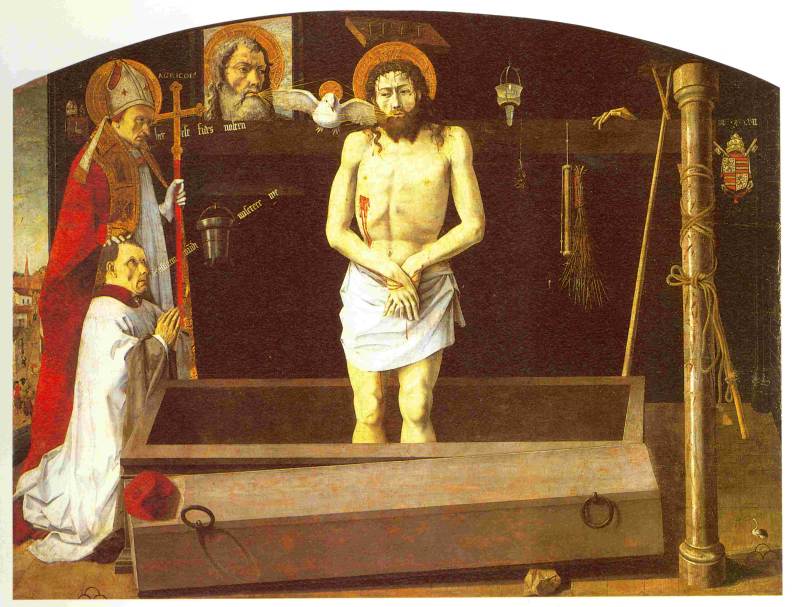 is presented an old painting ‘The New Testament Trinity with dead Christ’. On the right, on the cross-beam of the crucifix we see the SEVERED RIGHT HAND placed on the cross! Although the hands of Christ shown here are not damaged to such an extent, however the very fact of the presence of the SEPARATED RIGHT HAND most likely points out that some mediaeval artists still recalled, albeit vaguely, the severed right hand of Christ, see fig. 2.84
is presented an old painting ‘The New Testament Trinity with dead Christ’. On the right, on the cross-beam of the crucifix we see the SEVERED RIGHT HAND placed on the cross! Although the hands of Christ shown here are not damaged to such an extent, however the very fact of the presence of the SEPARATED RIGHT HAND most likely points out that some mediaeval artists still recalled, albeit vaguely, the severed right hand of Christ, see fig. 2.84 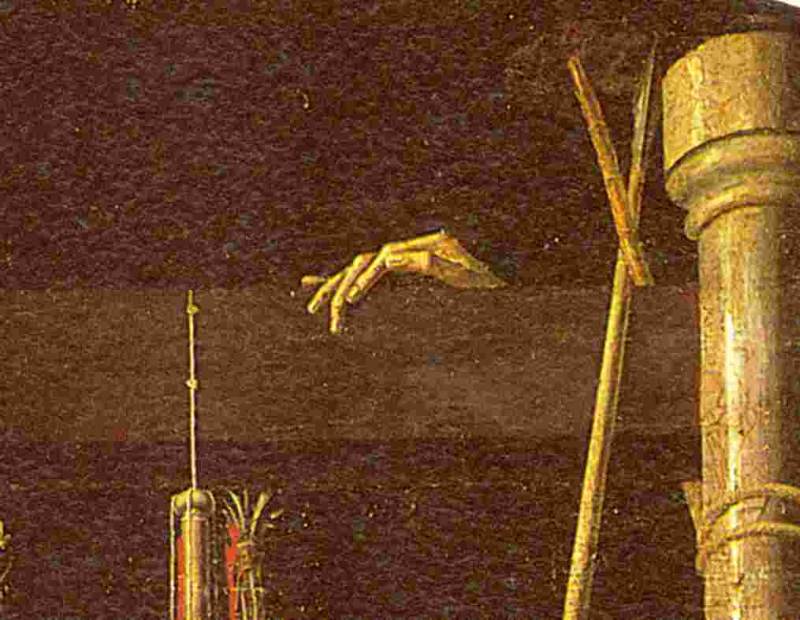 .
.
34. WHO BETRAYED CHRIST.
Usually the Gospel story is thought of in such a way that Christ was betrayed by the Judeans – the people of Jerusalem. They brought him to the Roman, Pilates, i.e. allegedly the foreigner, and demanded an execution. Hence there is made a conclusion that Judea at that time was under the rule of Rome, was governed by the Roman governor and rendered tribute to the Caesar who resided in distant Rome. Everyone knows the Gospel words of Christ: ‘Render therefore unto Caesar the things which be Caesar's, and unto God the things which be God's (Luke 20:25). In the synodical translation of the Gospel of John Pilates addresses Christ with the words: ‘Am I a Jew? Your own people and chief priests handed you over to me’ (John 18:35). The synodical translators and the contemporary commentators naturally were already under the influence of the scaligerian chronology and that is why thought that the words ‘Your own people’ should be understood as the entire Jewish nation and Pilates was a foreign Roman governor. Today however we understand that the true picture was different. Pilates was by no means a foreigner, but a Czar-Grad judge, so to say, the representative of the executive authority. He could not have said to Andronicus-Christ: ‘Your people handed you over to me’ as both Pilates and Christ belonged to the same people. They were both Romaeas, i.e. the Romans, the residents of Czar-Grad.
Let us address the older Church Slavonic text of the Gospels. We will use the edition of 1651 [141]. There is a different text there. Pilates’ words are presented in a different way: ‘Отвеща Пилатъ, еда азъ жидовинъ есмь; РОД ТВОЙ и архиерее предаша Тя мне’[144], page 187 reverse. Here Pilates speaks not about the people, but about Christ’s PEOPLE meaning FAMILY. This is an entirely different thing. His relatives, his family clan is meant here. But then we are starting to understand, who were the evangelical Jews. This was the name of CHRIST’S FAMILY CLAN, i.e. royal family clan ruling in Czar-Grad. I.e. the dynasty of the Komnenoi and the Angels. They were relatives. Pilates, on the other hand, did not belong to this family clan, he was an executive. And indeed in the story of Andronicus the theme of betrayal by relatives and the nobility is loudly resonant. It was them who hated Andronicus and executed him.
35. PASSION OF CHRIST AND ANDRONICUS’ EXECUTION.
The story of Passion of Christ is well known from the Gospels and the other Christian works, see for example a book ‘Strasti Christovy’ (‘Passion of Christ’) [127]. We will not give a separate description of it here as the reader can address the traditional texts. We shall say straight away that the canonical description of Passion of Christ and the story of Andronicus’ execution presented for example by Choniates, are strikingly similar. Andronicus’ execution consists of all the three stages of Passion of Christ: the preliminary torture, the road to the place of crucifixion, the execution itself before a vast crowd of spectators.
Here is what Choniates writes: ‘He was confined to the so called prison of Anemas WITH TWO HEAVY CHAINS WEIGHING DOWN HIS PROUD NECK… and his feet were painfully shackled. Bound in this fashion he was paraded before Emperor Isaac (Angel – Author). He was slapped in the face, his beard was torn off, his teeth pulled out, his head shorn of hair; he was made the common sport of all those who gathered… Afterwards, his right hand cut off by an axe, he was cast again into the same prison without food or drink … Several days later, his left eye was gouged out, and, seated upon a mangy camel, he was paraded through the agora…But the stupid and ignorant inhabitants of Constantinople … gathered together… gave no thought to the fact that but a few short days earlier this man had been emperor. That he had been hailed as SAVIOUR, acclaimed and adored by all… that they had confirmed their loyalty and devotion to him by the most terrible oaths. Now carried away by unreasoning anger and an even greater madness, there was no evil which they did not inflict wickedly on Andronicus. Some struck him on the head with clubs, others befouled his nostrils with cow-dung, and still others, USING SPONGES POURED EXCRETIONS FROM THE BELLIES OF OXEN AND MEN OVER HIS EYES. There were those who pierced his ribs with spits. The more shameless among them pelted him with stones … And after that when he was dismounted off the shabby camel … he was suspended by his feet BY A CORD MADE OF CORK OAK FASTENED TO THE TWO SMALL COLUMNS ON WHICH RESTED A BLOCK OF STONE THAT STOOD NEAR THE RABID BRONZE SHE-WOLF AND HYENA whose necks were bent down as if they were going to attack each other’ [140], p.357-358.
We shall stop here for a moment. We all know that Christ was crucified on a cross which stood between the other two crosses, to which the two thieves were tied up, see fig. 2.85 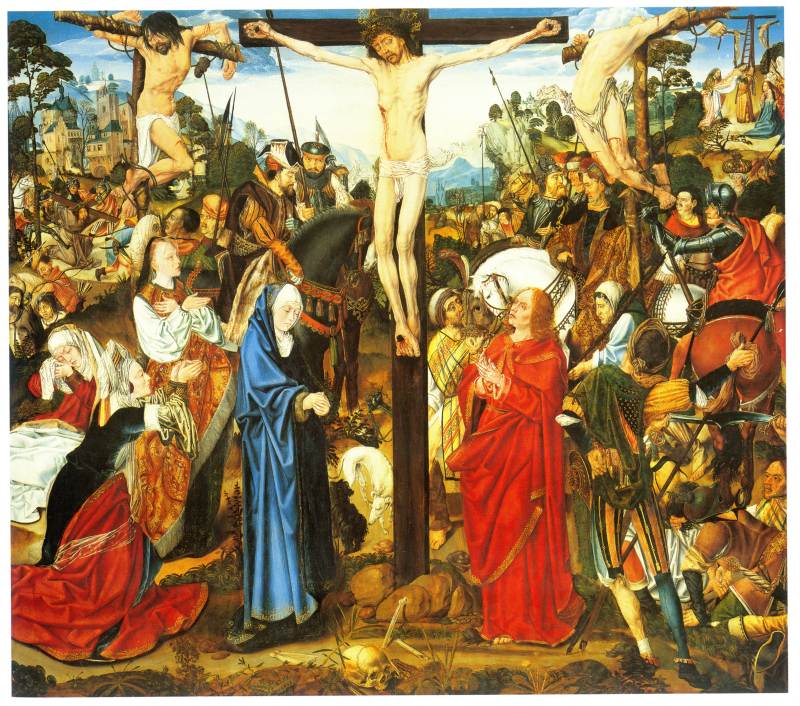 . All three crosses stood on mount Golgotha. I.e., so to speak, on some ‘big rock’. But on closer analysis of Choniates’ text we see that on the whole the same picture was described there, though in a slightly distorted way. It says that Andronicus was suspended between two columns connected at the top with some kind of a rock. Presumably it said in the original source text that he was suspended between two columns which stood on a rocky mountain. I.e. kind of ‘connected by a rock’, but not from above, but from below.
. All three crosses stood on mount Golgotha. I.e., so to speak, on some ‘big rock’. But on closer analysis of Choniates’ text we see that on the whole the same picture was described there, though in a slightly distorted way. It says that Andronicus was suspended between two columns connected at the top with some kind of a rock. Presumably it said in the original source text that he was suspended between two columns which stood on a rocky mountain. I.e. kind of ‘connected by a rock’, but not from above, but from below.
According to the Gospels the two thieves were tied to the posts-crosses, see fig.2.86  . Instead ‘Choniates’ says in that place the columns stood near some ‘rabid bronze statues’. Once again the original Gospel text shines through. But instead of the thieves ‘a she-wolf and a hyena’ are mentioned.
. Instead ‘Choniates’ says in that place the columns stood near some ‘rabid bronze statues’. Once again the original Gospel text shines through. But instead of the thieves ‘a she-wolf and a hyena’ are mentioned.
Moreover, such a description by Choniates could by no means have been just a consequence of some accidental error. His text corresponds well with the symbolical depiction of the crucified thieves on the ‘Ancient’ Egyptian paintings. See for example fig.2.87 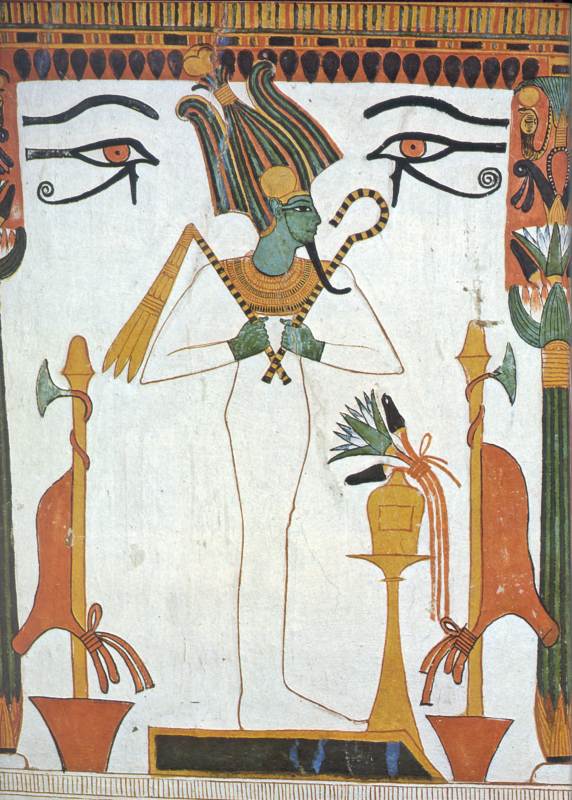 . Here is shown Osiris risen from the dead. On each side from him there are two posts. To each of them a beheaded animal is been tied up. Egyptian Osiris is Christ, see below. The fact the animals are beheaded means that they were executed. On the whole the symbolism of the Egyptian pictures fully corresponds to the Christian crucifixion. Christ was crucified amongst the two thieves and was resurrected, and both thieves died. This ‘Ancient’ Egyptian image corresponds well with the text by Choniates.
. Here is shown Osiris risen from the dead. On each side from him there are two posts. To each of them a beheaded animal is been tied up. Egyptian Osiris is Christ, see below. The fact the animals are beheaded means that they were executed. On the whole the symbolism of the Egyptian pictures fully corresponds to the Christian crucifixion. Christ was crucified amongst the two thieves and was resurrected, and both thieves died. This ‘Ancient’ Egyptian image corresponds well with the text by Choniates.
In regards to Choniates’ words about Andronicus being suspended by his feet, then we should not necessarily conclude that he was hung upside down, with his feet tied up to some bar. They also used to HANG (crucify) people on the crucifix, while tying up or nailing not only hands, but feet too.
Choniates informs us, that on the way to the place of execution ‘some struck him on the head with clubs, others befouled his nostrils with cow-dung, and still others, USING SPONGES POURED EXCRETIONS FROM THE BELLIES OF OXEN AND MEN OVER HIS EYES [140], p.358.
Matthew the Evangelist literally says the same thing: ‘And they spit upon him, and took the reed, and smote him on the head… And when they were come unto a place called Golgotha, that is to say, a place of a skull, THE GAVE HIM VINEGAR TO DRINK MINGLED WITH GALL: and when he had tasted thereof, he would not drink (Matthew 27:30-34). Luke writes, that they repeatedly treated Christ to vinegar, i.e. gunk: ‘And the soldiers also mocked him, coming to him, and offering him vinegar’ (Luke 23:36). The same was said about Andronicus.
Choniates continues: ‘Suffering all these evils and countless others which I have omitted, he held up bravely under the horrors inflicted upon him and remained in possession of his senses. To those who poured forth one after another and struck him, he turned and said no more than ‘Lord, have mercy’, and ‘Why do you further bruise the broken reed?’… A certain ungodly man DIPPED HIS LONG SWORD into his entrails by way of the pharynx … After so much suffering, Andronicus broke the thread of life, HIS RIGHT ARM EXTENDED IN AGONY AND BROUGHT AROUND TO HIS MOUTH SO THAT IT SEEMED TO MANY THAT HE WAS SUCKING OUT THE STILL-WARM BLOOD DRIPPING from a recent amputation’ [140], p.358.
According to Choniates Andronicus before drawing his last breath he passed his arm against his mouth as if he was thirsty. We read almost identical thing in the Gospels. 'After this, Jesus, knowing that all things were now accomplished, that the Scripture might be fulfilled, said, “I thirst!” Now a vessel full of sour wine was sitting there; and they filled a sponge with sour wine, put it on hyssop, and put it to His mouth. So when Jesus had received the sour wine, He said, “It is finished!” And bowing His head, He gave up His spirit’ (John 19:28-30).
Thus in the both descriptions it is stressed that Christ-Andronicus before his death was thirsty. We would like to note that this is a very unusual detail. It appears seldom in the description of executions.
John the Evangelist writes: ‘But when they came to Jesus, and saw that he was dead already, they broke not his legs. But one of the soldiers WITH A SPEAR PIERCED HIS SIDE, and forthwith came there out blood and water (John 19:33-34). This spear is usually depicted next to the cross, see fig.2.61  , fig.2.62
, fig.2.62 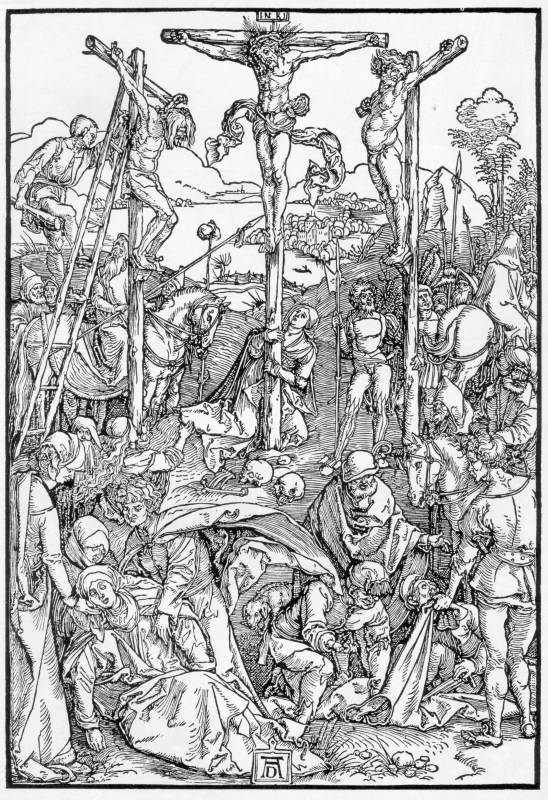 and fig.2.63
and fig.2.63 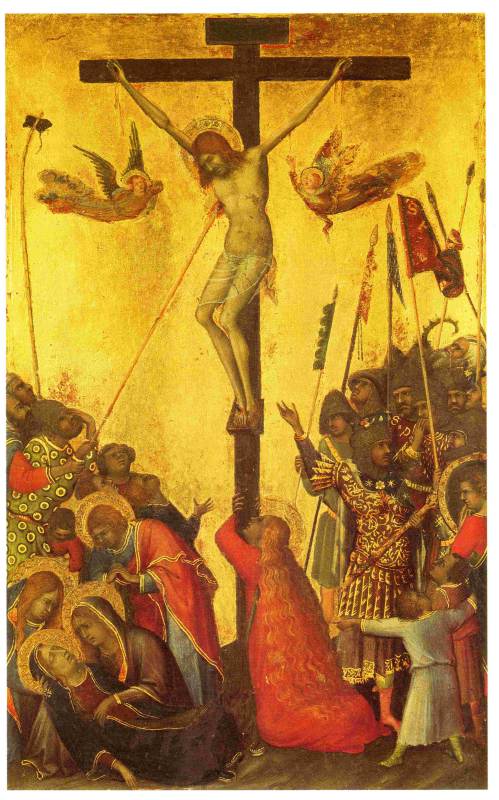 . In Andronicus’ case we can see a similar description: a soldier pierced him with his long sword, see above. ‘A long sword’ could easily signify a spear.
. In Andronicus’ case we can see a similar description: a soldier pierced him with his long sword, see above. ‘A long sword’ could easily signify a spear.
36. DEPOSITION FROM THE CROSS, THE ENTOMBMENT AND RESURRECTION.
Let us remind you what the Gospel say about the deposition of Christ, his entombment and resurrection. John writes: ‘And after this Joseph of Arimathaea, being a disciple of Jesus, but secretly for fear of the Jews, besought Pilate that he might take away the body of Jesus: and Pilate gave him leave. He came therefore, and took the body of Jesus. And there came also Nicodemus, … and brought a mixture of myrrh and aloes, about an hundred pound weight. Then took they the body of Jesus, and wound it in linen clothes with the spices, as the manner of the Jews is to bury... The first day of the week cometh Mary Magdalene early, when it was yet dark, unto the sepulchre, and seeth the stone taken away from the sepulchre. Then she runneth, and cometh to Simon Peter, and to the other disciple, and saith unto them, they have taken away the Lord out of the sepulchre, and we know not where they have laid him’ (John 19:38-40; 20:1-2).
Choniates writes the following about Andronicus’ deposition: ‘After several days, his body was taken down from the most pitiable gallows and pitched into one of the vaults of the Hippodrome … (i.e. very close to the place where Andronicus was executed –Author). Later, certain people who displayed some measure of compassion … removed Andronicus’ corpse and laid it to rest in the lowest district near the Monastery if Ephoros which is situated at the Zeuxippon; even now it not completely decomposed as can be seen by those who which to look’ [140], p.360.
When comparing the two accounts we see the following. Firstly, in both cases it is said that the body was taken down and buried somewhere very close by. In one instance – it is a new sepulchre, as if by chance happening to be near the crucifixion site. In the other – some ‘vault’ in the Hippodrome. I.e. at the very place where Andronicus was executed.
Secondly, in the both instances the body was tended to not by the executioners or the relatives, but by some strangers. The gospels speak of the secret Disciples of Christ – Joseph and Nicodemus. While Nicetas Choniates writes about certain nameless compassionate people.
Thirdly, - and it is the most incredible thing, in both cases ‘the burial fails’ and Christ’ body disappears. And in regards to Andronicus body the strange statements are being made, that allegedly ‘even now’ it is not completely decomposed and can be seen by those who wish to look. But ‘Historia’ by Nicetas Choniates spans over quite a large time scale. It ends with 1206, i.e. twenty years later after Anronicus’ death. So does it mean that all these years Andronicus’ body was lying there ‘not decomposing’? Most likely, in the source text, which was edited by Choniates, something very different was said. It is possible that it was quite clear that the body disappeared and Andronicus was resurrected. ‘Choniates’ probably attempted to erase the obvious analogy with Christ and did it quite awkwardly. At the very least we can see a clear peculiarity at this point in the text by Nicetas Choniates. About no other king did Nicetas Choniates say that ‘he was never consigned to the grave’. This detail is unique to Andronicus.
Thus all the three main moments of the Gospel narrative: deposition from the cross, burial and resurrection are present in Choniates’ accounts either openly, or in a way of the traces after the edition of the Gospel story.
CONCLUSION. The aforesaid match between the Gospel story of Christ and the surviving accounts of Andronicus’ life covers virtually all the major events of their biographies. Sometimes this match runs to the tiniest of details. Where quite often it allows us a much better understanding of the true meaning of the Gospel story. We would like to stress that the overlapping of the biographies of Christ and Andronicus happened entirely formally as a result of the chronological calculations. We did not purposefully look for a historical character with evangelical biographical traits. That is why such a dramatic correspondence, which one could not have wished to be better, says that we correctly pointed out a spot in the known history, where the original Gospel events took place. Specifically, the second half of the XII century. It ought to be said that Nicetas Choniates’ text should not be considered as a reliable and original evidence by a contemporary, as it is usually presented [140], p.5-8. Choniates has many vague places and repetitions where the same event is described several times from different angles, see below. Besides, there is a taste of emotional hostility towards Andronicus-Christ in it. This should be considered when analysing his ‘Historia’. Nevertheless Choniates’ text wonderfully compliments the Gospels. Now, having both accounts, we understand the Gospel events much better and more clearly, than before.
37. WHY THE EARLY-CHRISTIAN AUTHORS CLAIMED THAT CHRIST‘S SECOND COMING WILL HAPPEN IN THE EIGHTH CENTURY.
In the early Christian literature there used to be an opinion that the second coming of Christ will occur in the eighth century. One of the fathers of the church, Cyril of Jerusalem, wrote a special work manuscript called ‘Иже во святыхъ отца нашего Кирилла патриарха Иерусалимскаго сказание НА ОСЬМЫЙ ВЕКЪ, и предание къ познанию веры, яко же Христосъ паки приити иматъ судити живымъ и мертвымъ, его же царствию не будет конца’ [77], p. 95.
There was a lot of speculation and theories regarding this topic. But no one gave a clear explanation as to how the eighth century enters the picture. However now everything clicks into place. To clarify, the Christian doctrine about the second coming is based on the words of Christ passed on in the Gospels (Luke 17:22-37). Here it tells us about the second coming in detail. Besides, the following passage in the Gospel of Matthew is considered to also refer to the second coming. Christ says: ’Verily I say unto you, There be some standing here, which shall not taste of death, till they see the Son of man coming into his kingdom’ (Matthew 16:28). As we understand it now, these words were said by Christ-Andronicus about his future reign, which will come soon. Nevertheless they were comprehended as a prophecy about the second coming. Which incidentally was to come SOON. As it is said that some standing here shall not taste of death. Indeed the first Christians expected the IMMINENT End of Time (Judgement Day) and the second coming. This fact is known from the Church history. But then it becomes clear why the subject of the matter was specifically the eighth century. Andronicus-Christ was crucified in 1185 A.D. But the ‘A.D.’ (The New Era’) occurred much later. Before then the Russian-Byzantine era was used ‘since the creation of the world’ (anno mundi) or ‘from Adam’. According to it the crucifixion took place in 6693, as 1185 + 5508 = 6693. Or in ‘693’ as thousands (000) were often omitted in the old dates. Even as late as in the XVII century when writing down years ‘from Adam’ they often omitted thousands (000).
But year 693 is the very end of the seventh century. Therefore the second coming of Christ was awaited quite soon, as early as ‘in the eighth century’. In other words, in the end of the XII – XIII cc A.D. We are getting the perfect correspondence with our reconstruction.
38. THE PROPHECY OF HIS OWN DEATH BY CHRIST-ANDRONICUS.
According to the Gospels Christ long before entering Jerusalem PREDICTED his sufferings and death on the cross (Matthew 16:21-28; Мark 8:31 - 9:1; Luke 9:22-27). For example here is what Mark writes: ‘And he began to teach them, that the Son of man must suffer many things, and be rejected of the elders, and of the chief priests, and scribes, and be killed, and after three days rise again’. And he spake that saying openly’ (Mark 8:31-32).
Andronicus is doing the same thing. He beforehand, a long time prior to becoming an emperor, predicted the exact place of his execution. Nicetas Choniates wrote: ‘The story has come down to us that once, during the horse races, Andronicus extended his hand and pointed out to his cousin Emperor Manuel THE COLUMNS BETWEEN WHICH HE HIMSELF WOULD BE SUSPENDED and said that one day an emperor of the Romans would be hanged there and ill-treated by the entire City’s populace’[140], p.359.
39. THE PHARISEES AND SADDUCEES ARE PRASINOI (THE GREENS) AND VENETOI (THE BLUES) IN CZAR-GRAD.
In The New Testament there are often mentioned the then existing in Jerusalem clans of Pharisees and Sadducees or Scribes and Pharisees. See for example (Matthew 3:7, 7:29, 16:1, 22:34; Luke 5:21, 5:30, 15:2, 20:27; Mark 2:16, 7:5; John 8:3), etc. They were certain parties vying for power in Jerusalem as becomes clear from the following place in The Acts. They are talking about Paul coming before the Synedrion: ’But when Paul perceived that the one part were Sadducees, and the other Pharisees, he cried out in the council, Men and brethren, I am a Pharisee, the son of a Pharisee: of the hope and resurrection of the dead I am called in question. And when he had so said, there arose a dissension between the Pharisees and the Sadducees: and the multitude was divided… And there arose a great cry: and the scribes that were of the Pharisees' part arose, and strove, saying, We find no evil in this man …’ (The Acts 23:6-9).
Christ often argues, particularly with Pharisees. Only in the Gospel of Matthew alone we come across the following address seven times: ‘woe unto you, scribes and Pharisees, hypocrites!’ (Matthew 23:13-29).
But this accurately corresponds with the description of the mediaeval Czar-Grad, where an important role was played by the two parties – prasinoi and venetoi. They were called Deme. It is thought that ‘demes, the main circus parties of sports fans in Byzantine cities’, by the V century transformed into the political parties. They remained significantly important up until the IX century. There were four main colours of the parties… - venetoi (the blues), prasinoi (the greens), rousioi (the reds) and leukoi (the whites). The first two were of the most importance [44], p.334. It is true, however, that in the XII century, in the times of Andronicus, these parties ‘became a thing of the past’, instead of them in Byzantium their place was taken by: the Western party of the Latins and the Eastern Russian party of the ‘barbarians’ – the Varangians. Much emphasis is placed on the Latins and the Varangians in the biographies of Andronicus. To remind you he was a foe to the Latins and an advocate of the ‘barbarians’, see above. As we will see the pages of the early Byzantine history are in fact overflowing with the duplicates in the biographies of Andronicus. Hence there arises a distinct impression that ‘the more earlier’ pracinoi and venetoi and the ‘more recent’ Latins and Slavs are simply the same thing. All the more so as the VENETOI is a well known mediaeval name of the Slavs, see the book ‘Imperia’ (‘The Empire’ – Translator) and CHRON5, ch.11:5.2. For example, a famous mediaeval author Siegmund von Herberstein reports that in Germany even in the XVI century all the Slavs were called the WENDS or the VENETI, i.e the VENETOI [37], p.58.It appears that the Gospel Pharisees are Czar-Grad prasinoi, aka the Latins. And the Gospel Sadducees are most likely Czar-Grad venetoi. What jumps out at you is the fact that the words PHARISEES and PRASINOI are quite similar. We’ll remind you that letters PH easily could transfer into P and vice versa. Until now in some Western European languages the sound F could be denoted by letters ph (Latin), i.e. a breathy P.
Hence Christ’s bad relationship with the Pharisees repeatedly alluded to in the Gospels, precisely match Andronicus’ strained relationship with the Latins. Which also repeatedly highlighted by Nicetas Choniates, see above.
And one more observation. Today they are trying to convince us that prasinoi and venetoi were allegedly originally the circus parties. Most likely an error has slipped in here. Instead of the word ‘circus’ they should have been put the word ‘church’. There were ECCLESIASTIC, religious differences between the existing parties. But by no means the circus ones. As between the parties of Pharisees and Sadducees. See for example The Acts, where it said as follows: ‘For the Sadducees say that there is no resurrection, neither angel, nor spirit: but the Pharisees confess both’ (The Acts 23::8). The matter at hand is clearly some religious differences.
40. THE PARTICIPATION OF THE LATINS IN THE EXECUTION OF CHRIST-ANDRONICUS.
Nicetas Choniates stresses the most direct participation of the LATINS in the execution of Andronicus: the certain members of the LATIN race raised their swords with both hands above his buttocks and standing around him they brought them down making trial as to whose cut was deeper’ [141], p.253. Thus Nicetas Choniates already in the second volume of his manuscript when speaking of the LATINS, writes: ‘What Christ endured from these people, having been stripped and abused’ [141, p.253. Thus Choniates states straightforwardly that Christ, as well as Andronicus, was tortured by the Latins. We would like to note that according to the Gospels Christ was executed by the Roman soldiers. The participation of the Latins is not stressed there, though it does not contradict the Gospels texts. As there could have been Latins among the Roman soldiers.
The excerpt from Choniates presented above resonates with the Gospel of Mark. Choniates writes, that the Latins were striking Andronicus from the back. That means, he did not see who exactly was striking him. Mark gives a similar description: ‘And some began … to cover his face, and to buffet him, and to say unto him, Prophesy: and the servants did strike him with the palms of their hands (Mark 14:65). Which means that they were beating Christ in such a way, that he did not see the person who was doing it.